Intel Core i7-11700K Review: Blasting Off with Rocket Lake
by Dr. Ian Cutress on March 5, 2021 4:30 PM EST- Posted in
- CPUs
- Intel
- 14nm
- Xe-LP
- Rocket Lake
- Cypress Cove
- i7-11700K
Gaming Tests: Gears Tactics
Remembering the original Gears of War brings back a number of memories – some good, and some involving online gameplay. The latest iteration of the franchise was launched as I was putting this benchmark suite together, and Gears Tactics is a high-fidelity turn-based strategy game with an extensive single player mode. As with a lot of turn-based games, there is ample opportunity to crank up the visual effects, and here the developers have put a lot of effort into creating effects, a number of which seem to be CPU limited.
Gears Tactics has an in-game benchmark, roughly 2.5 minutes of AI gameplay starting from the same position but using a random seed for actions. Much like the racing games, this usually leads to some variation in the run-to-run data, so for this benchmark we are taking the geometric mean of the results. One of the biggest things that Gears Tactics can do is on the resolution scaling, supporting 8K, and so we are testing the following settings:
- 720p Low, 4K Low, 8K Low, 1080p Ultra
For results, the game showcases a mountain of data when the benchmark is finished, such as how much the benchmark was CPU limited and where, however none of that is ever exported into a file we can use. It’s just a screenshot which we have to read manually.
If anyone from the Gears Tactics team wants to chat about building a benchmark platform that would not only help me but also every other member of the tech press build our benchmark testing platform to help our readers decide what is the best hardware to use on your games, please reach out to ian@anandtech.com. Some of the suggestions I want to give you will take less than half a day and it’s easily free advertising to use the benchmark over the next couple of years (or more).
As with the other benchmarks, we do as many runs until 10 minutes per resolution/setting combination has passed. For this benchmark, we manually read each of the screenshots for each quality/setting/run combination. The benchmark does also give 95th percentiles and frame averages, so we can use both of these data points.
| AnandTech | Low Resolution Low Quality |
Medium Resolution Low Quality |
High Resolution Low Quality |
Medium Resolution Max Quality |
| Average FPS | 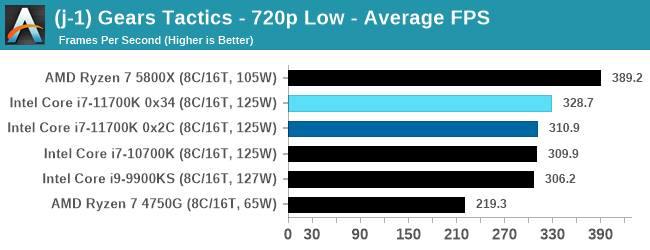 |
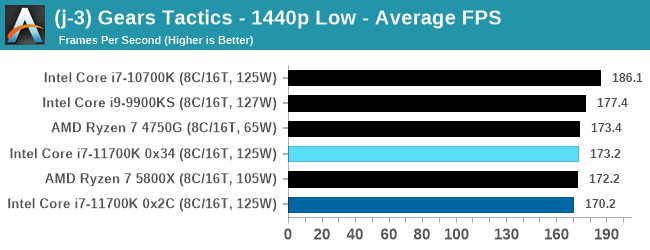 |
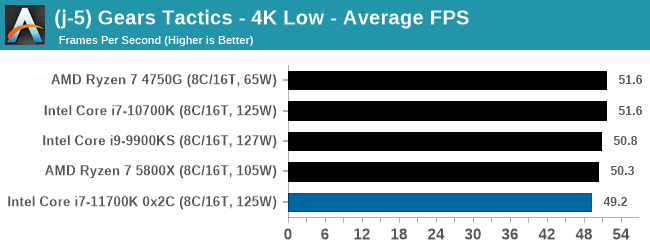 |
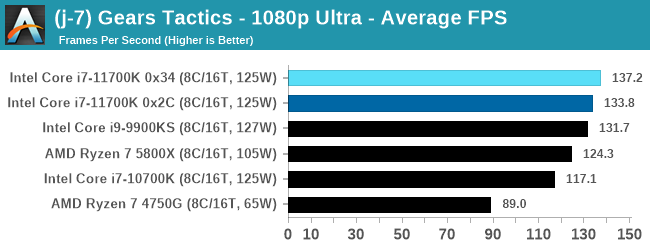 |
| 95th Percentile | 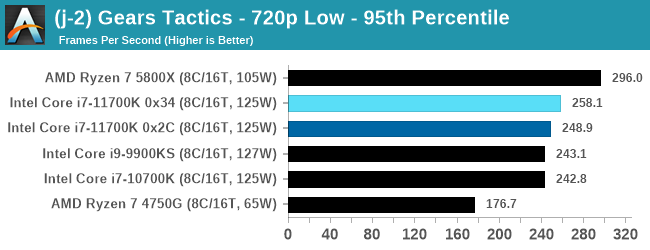 |
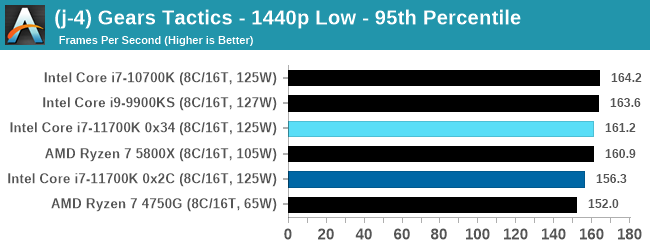 |
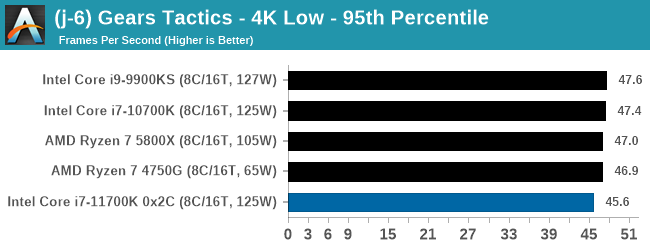 |
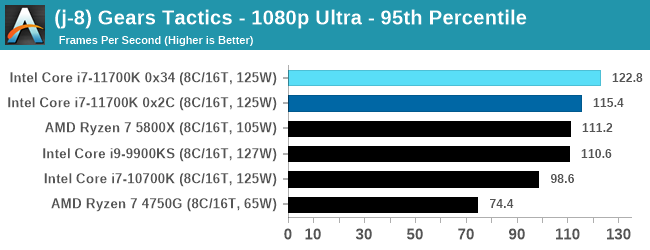 |
Gears is the one test where at our 1080p Maximum settings it shines ahead of the pack. Although at high resolution, low quality, although all five CPUs are essentially equal, it still sits behind AMD's Ryzen APU.
All of our benchmark results can also be found in our benchmark engine, Bench.


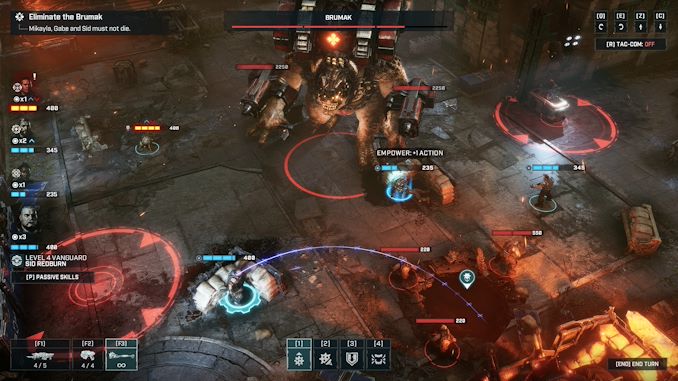









541 Comments
View All Comments
brucethemoose - Monday, March 8, 2021 - link
1: AT benches on Windows, and right now x86 vs ARM is kinda Apples-to-oranges on that platform, especially when one starts mixing in emulation and AVX.Give it time. More comparisons will come. But you'll probably see comparisons on Linux/Mac, and open source software in general, sooner.
2: People uses CPUs for different things. Some of these benches are relevant to those people.
At the same time, my use cases weren't really covered here, so... I get what you're saying.
3. Yeah, it seems rather silly to me, especially when Anand test GPU limited AAA games.
Where you really need a big CPU is in simulation/sandbox games, especially in servers for such things, and sluggish early access stuff. But no one ever benches those :/
Silver5urfer - Monday, March 8, 2021 - link
So with the 19% IPC claim and losing to 9900KS and 10700K what is the point of releasing this chip, from Intel. I never got much from AT benches a lot and preferred the Hardware unboxed, Gamernexus guys and others. But if this is the final performance figures, then this is really a DOA product from Intel. How can they allow this ? I never saw Intel in such a position..maybe X299 got rekted when Zen 2 dropped but this is mainstream segment.Damn it. AMD processors have the idiotic stock related issues, add that WHEA and USB shitstorm. Intel has bullshit performance over past gen except a Gen4 addition and extra lanes from chipset. GPUs are out of damn stock as well.
2020 and 2021 both are completely fucked up for PC HW purchases.
Gigaplex - Monday, March 8, 2021 - link
"I never saw Intel in such a position.."The Pentium 4, in particular the Prescott architecture was a dud back in the early 2000's. That era spawned the antitrust lawsuit against Intel for illegally blocking AMD sales since the Intel products weren't competitive.
dwbogardus - Monday, March 8, 2021 - link
The fact that Intel can even remain in a close second place, using a 14 nm process is impressive. Imagine what they could do with TSMC's 7 nm process! It would almost certainly outperform AMD by a significant margin.Bagheera - Monday, March 8, 2021 - link
Really tired of Intel fanboys saying this.architectures are designed for specific nodes - RKL's problems are exactly due to porting an arch onto a node it wasn't designed for.
the fact is Intel is not a partner for TSMC and their archs are not designed for TSMC processes. if Intel were to outsource CPU production to TSMC, they will either have to make a new arch or make make tweaks to existing ones - a multi-million $ endeavor with risms of issues like your just read with RKL.
Hifihedgehog - Tuesday, March 9, 2021 - link
> a close second place^Here we see in his natural environment your common everyday dude who fails at reading comprehension. I guess you didn't read the part about the serious gaming performance losses and latency regressions gen-over-gen, the 10% performance gap in single-threaded or 10-20%+ performance gaps in multithread, or the inexcusably high peak power draw? Talk about deluded...
RanFodar - Monday, March 8, 2021 - link
Though their efforts may be futile, I am glad Intel attempted to do something out of the ordinary; not a Skylake refresh, but a backport that is found to have worse performance. And yet, it is an attempt for Intel to learn their lessons for generations to come.Hifihedgehog - Tuesday, March 9, 2021 - link
Backporting is not a lesson; it is a last ditch effort or a fallback when all else fails on the manufacturing side. Half full, half empty cup viewing aside, they wasted even more valuable engineering manhours into a failed backport when it should have been invested into developing new architectures. A best use would have been developing the next release. The problem is Intel had to make Rocket Lake good enough in synthetic benchmarks to appease their investors. That, however, still does not address the elephants in the room of 10-20% single threaded performance gaps or—the one that takes the cake—the latency regressions that makes gaming worse, Intel’s historic crown jewel. Much like movies that fail at release and live on box office bombs that their producers later opine should have been cut early on in development, Intel should have cut this idea early on. If you are looking for a lesson that Intel should have learned here, there it is: avoid another Rocket Lake backporting disaster and just warm over your current microarchitecture with one more middling refresh one last time.Hifihedgehog - Tuesday, March 9, 2021 - link
Ian, I just want to say thank you for the incredible review. Just ignore the haters on social media and in the comments who get their panties in a bunch. If the product is garbage, say it like it is, like you did and quite well I might add. You were incredibly diplomatic about it and even openly and honestly showed when and where Intel did win on the rare occasion in the benchmarks. It is so silly how people make these CPU companies (who don't know them from Sam Hill) their religion, as if erecting a Gordon Moore or Lisa Su shrine would avail them anything. Silly geese.misiu_mp - Wednesday, March 10, 2021 - link
Is that the new bulldozer?